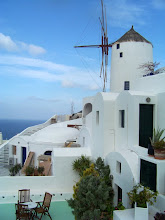I'm working on a rendering for a building in Haiti this week, which makes me wonder about the architecture there. What kind of building should we propose for the people and environment there as Haiti remains the poorest Caribbean country?
I found The Sun House, an earthbag building project at Pwoje Espwa in Southern Haiti. Father Marc Boisvert, the founder and director of Pwoje Espwa (http://www.freethekids.org/), has dedicated his life to serving and helping suffering children. This project not only houses over 700 children, but has an agricultural project, three schools, carpentry and masonry facilities, and an arts and crafts program.

The finished building is quite charming especially after the local artists' decoration. What a perfect fusion of the sustainable building techniques and the unique Haitian art and culture! More process photos can be found here: http://earthbagbuilding.com/projects/haiti.htm

The website EarthBuilding.com offers comprehensive information on earthbag construction, and I learned a lot about the advantages of this building technique. First, earthbag building is very low-cost and easy to build. Second, earthbags function well as either thermal mass or insulation, depending on what the bags are filled with. Third, earthbag structure can be fairly strong if properly constructed. Fourth, earthbag technique works better with non-rectilinear shapes, thus becomes a great tool for creating unique sculptural forms. I'm so tempted to build one myself!
As my Haitian dream continues, I watched Divine Horsemen: The Living Gods of Haiti, an unfinished documentary made by Maya Deren filming the voodoo rituals in Haiti. It's remniscent of Eisenstein's unfinished masterpiece ¡Que viva Mexico! which captures the soul of Mexican culture and its tragic history.
I found The Sun House, an earthbag building project at Pwoje Espwa in Southern Haiti. Father Marc Boisvert, the founder and director of Pwoje Espwa (http://www.freethekids.org/), has dedicated his life to serving and helping suffering children. This project not only houses over 700 children, but has an agricultural project, three schools, carpentry and masonry facilities, and an arts and crafts program.

The finished building is quite charming especially after the local artists' decoration. What a perfect fusion of the sustainable building techniques and the unique Haitian art and culture! More process photos can be found here: http://earthbagbuilding.com/projects/haiti.htm

The website EarthBuilding.com offers comprehensive information on earthbag construction, and I learned a lot about the advantages of this building technique. First, earthbag building is very low-cost and easy to build. Second, earthbags function well as either thermal mass or insulation, depending on what the bags are filled with. Third, earthbag structure can be fairly strong if properly constructed. Fourth, earthbag technique works better with non-rectilinear shapes, thus becomes a great tool for creating unique sculptural forms. I'm so tempted to build one myself!
As my Haitian dream continues, I watched Divine Horsemen: The Living Gods of Haiti, an unfinished documentary made by Maya Deren filming the voodoo rituals in Haiti. It's remniscent of Eisenstein's unfinished masterpiece ¡Que viva Mexico! which captures the soul of Mexican culture and its tragic history.





